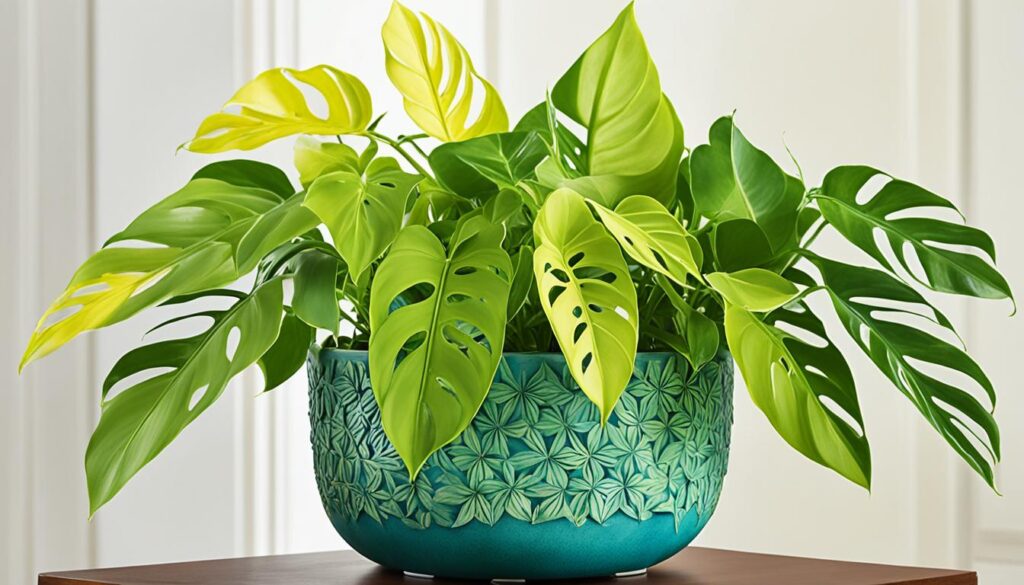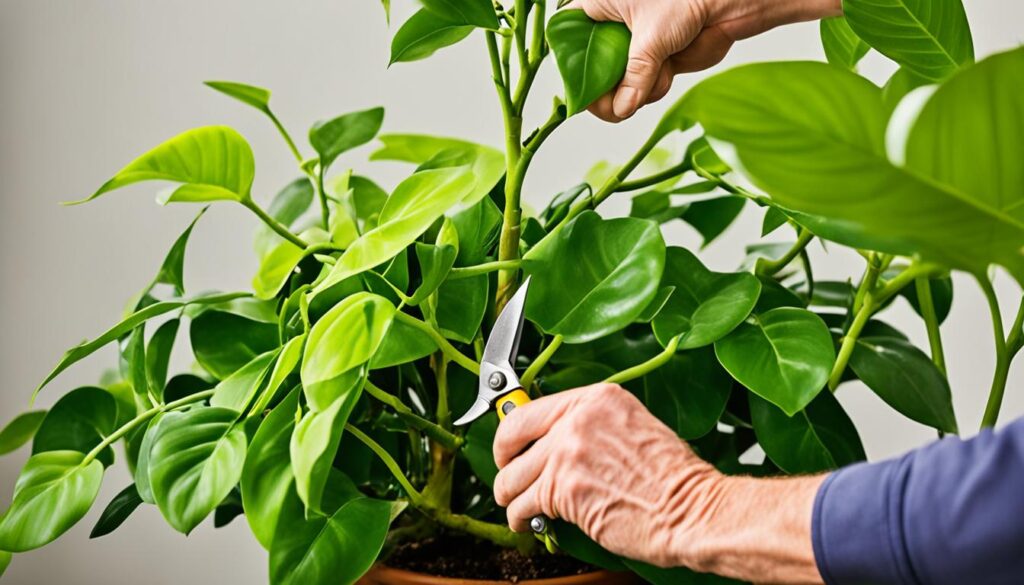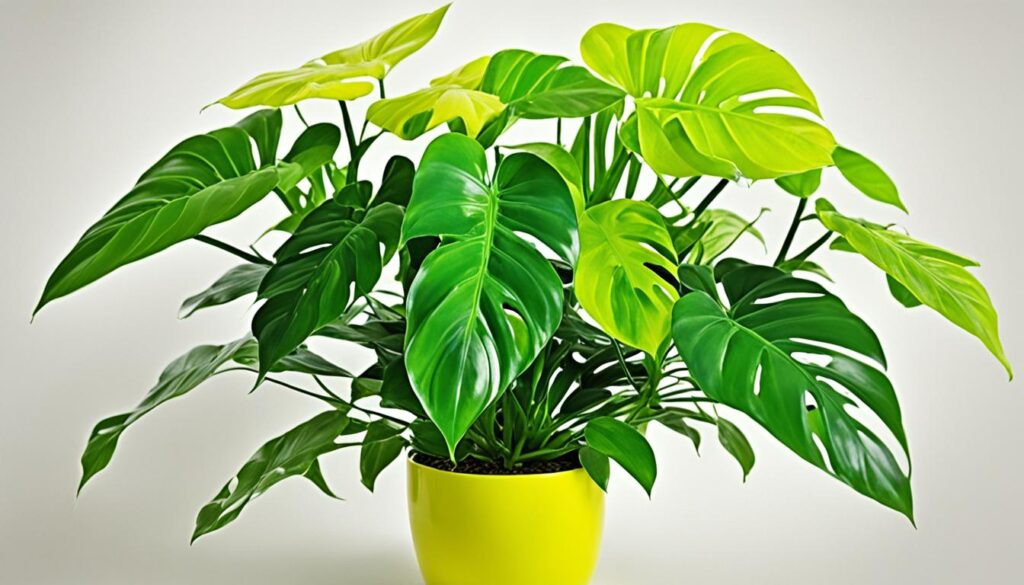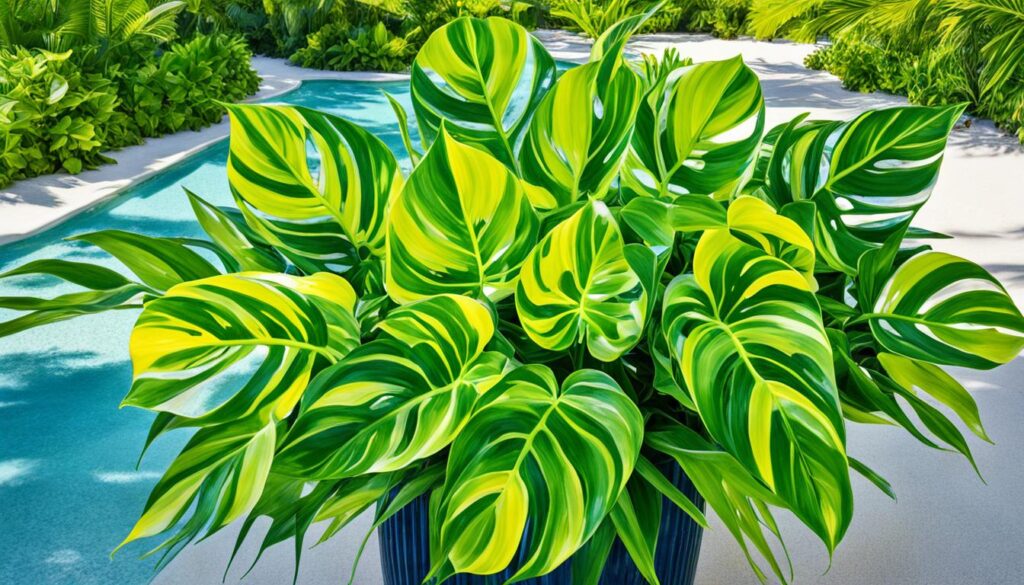Did you know the lemon lime philodendron is loved by many around the world? It’s a bright tropical plant with vines that grow down and leaves that change color. These colors shift from bright yellow to deep green, making it stand out indoors.
This plant is easy to take care of and can grow well in different light. It’s perfect for adding a tropical feel to your home or office. Plus, it helps clean the air and grows in many ways, making it a top pick for indoor gardening.
Key Takeaways
- Lemon lime philodendron is a vibrant tropical houseplant with cascading vines and variegated foliage
- It is a low-maintenance, easy-care plant that can thrive in various lighting conditions
- This plant offers air-purifying benefits and versatile growth habits, making it a popular choice for indoor spaces
- Lemon lime philodendron is suitable for homes, offices, and plant collections worldwide
- The plant’s striking color transition from bright yellow to deep chartreuse adds a touch of tropical flair to any decor
What is a Lemon Lime Philodendron?
The lemon lime philodendron, also known as Philodendron hederaceum ‘Lemon Lime’, is a beautiful tropical houseplant. It has vibrant leaves that change from bright yellow to chartreuse. This makes it a great choice for beginners or those with little gardening knowledge.
Vibrant Foliage and Cascading Vines
This plant has stems that can grow up to 12 feet long, perfect for trellises or hanging baskets. Its leaves are vibrant and variegated, adding a tropical touch to any room. The colors range from lemony yellows to vibrant lime greens.
Low-Maintenance Indoor Plant
The lemon lime philodendron is easy to care for and doesn’t need much attention. It can handle a variety of light levels, from medium to bright indirect sunlight. It also likes the soil to dry out a bit between waterings. This makes it great for busy people.
“The lemon lime philodendron is a stunning addition to any indoor space, with its vibrant foliage and cascading vines that create a tropical, eye-catching display.”
Caring for Your Lemon Lime Philodendron
To keep your lemon lime philodendron thriving, focus on the right lighting, watering, and humidity. This tropical plant is known for its vibrant, cascading foliage. But, it needs a bit of care to stay healthy.
Lighting Requirements
The lemon lime philodendron loves bright, indirect light. It can handle low-light spots but does best with filtered sunlight for several hours a day. Don’t put it in direct sunlight, as it can burn the leaves.
Watering and Humidity Needs
This plant likes consistent moisture but not too much. Let the soil dry out a bit before watering again. Don’t overwater, as it can cause root rot. It also does well in higher humidity, making it perfect for bathrooms or kitchens.
“Philodendrons like to dry out between waterings to avoid staying wet, and overwatering can harm the plant.”
Pay attention to your lemon lime philodendron’s lighting, watering, and humidity needs for a healthy plant. With proper care, this vibrant houseplant can brighten your indoor space with tropical beauty.

Lemon Lime Philodendron: Air-Purifying Houseplant
The lemon lime philodendron is not just known for its bright leaves and simple care. It’s also an air-purifying plant. This means it can clean the air in your home or office, making it healthier to breathe.
Research shows that indoor plants like the philodendron lemon lime can make you feel better. They help reduce stress and improve your mood. This plant is also seen as a sign of good luck in many cultures, symbolizing growth and wealth.
“Nurturing a Philodendron Lemon Lime offers therapeutic effects and can reduce stress, promoting mental well-being.”
The lemon lime philodendron is great at removing harmful toxins from the air. It can get rid of formaldehyde, benzene, and xylene. This makes it a top pick for places where clean air is important, like offices and homes.
This plant is also easy to take care of and can live in many indoor settings. It helps keep the air moist, which is good for your lungs and can prevent sickness.
If you want to make your space healthier or just add some color, the lemon lime philodendron is a great choice. It brings many houseplant benefits to your life.
Displaying Your Lemon Lime Philodendron
The lemon lime philodendron’s vines are perfect for hanging baskets and containers. They spill over the edges, creating a beautiful look. With bright yellow to chartreuse leaves, it brings tropical vibes indoors.
Hanging Baskets and Containers
Planting it in a hanging basket is a great way to show off the lemon lime philodendron. Its stems can grow up to 12 feet long, perfect for cascading. This makes the plant a stunning focal point in any room.
For a smaller space, the lemon lime philodendron fits well in various containers. You can place it on a tabletop, shelf, or windowsill. It easily blends into your decor.
Trellis and Climbing Support
For a structured look, train the lemon lime philodendron to climb a trellis. This shows off its lush growth and uses space well. The stems are strong enough to cling to a trellis, making a beautiful display.
When using a trellis, pick one that can hold the plant’s weight. Guide the vines and stems to the support to help the plant climb.

“The lemon lime philodendron’s cascading vines make it an excellent choice for hanging baskets and containers, where its vibrant foliage can spill over the edges and create a stunning visual display.”
lemon lime philodendron
The lemon lime philodendron is a unique and eye-catching tropical houseplant. It thrives in various indoor settings. Its vibrant foliage and cascading vines add a tropical flair to decor.
This plant is known for its striking, variegated leaves. They display a delightful blend of bright yellow, lime green, and deep green hues. The lemon lime philodendron belongs to the Philodendron family. These plants are hardy and purify the air.
The lemon lime philodendron thrives in different lighting conditions. It does well in bright, indirect sunlight and moderate light. This makes it perfect for various indoor spaces, from bright living rooms to dim corners.
This plant is also low-maintenance. With proper care, it can brighten your indoor space for years.
“The lemon lime philodendron is a true showstopper, adding a touch of tropical elegance to any room.”
Whether you’re an experienced plant parent or new to indoor gardening, the lemon lime philodendron is a great choice. It’s sure to capture your attention and bring tropical tranquility to your home.
Pruning and Maintaining Growth
Keeping your lemon lime philodendron looking great means regular pruning and care. Pinching or trimming the tips encourages bushier growth. This keeps the plant the right size and shape. With the right care, your lemon lime philodendron will thrive and look vibrant for years.
Prune your plant in the spring and summer to encourage new growth. Remove any yellow or damaged leaves to keep it healthy. But, don’t prune too much at once, as it can stress the plant. Pruning during the off-season can also disrupt its rest.
Always clean your tools before pruning to prevent disease. Use sharp tools for clean cuts that heal quickly and reduce stress. Dull tools can harm your plants, so keep them sharp and clean.
“Pruning may be necessary every three months during the growing season for Philodendron Lemon Lime.”
To grow lemon lime philodendron cuttings, pick healthy stems with several nodes. Let the cut end dry out before planting. Water-rooting takes changing the water every 2-5 days, while soil-rooting uses a mix with at least one node below the soil line. It can take 2-6 weeks for the cuttings to develop roots, with varying success.

It’s important to avoid mistakes when pruning your lemon lime philodendron. Don’t over-prune, use the right cutting techniques, and keep your tools clean. By doing so, your plant will keep thriving and add a tropical touch to your space.
Soil and Fertilizer Requirements
To thrive, the lemon lime philodendron needs well-draining potting soil. This soil should have the right balance of nutrients and air. The ideal soil pH is between 6.1 to 7.5 for good nutrient uptake and growth.
Well-Draining Potting Soil
It’s important to pick a well-draining potting mix for the lemon lime philodendron. This prevents root rot by allowing excess water to drain. Use a mix made for tropical plants or one with peat moss, perlite, and bark chips for good drainage and air.
Fertilizing for Optimal Growth
Feed the lemon lime philodendron with fertilizer during its active growing season, from spring to summer. Use a balanced, water-soluble fertilizer at half strength every 2-4 weeks. This keeps the foliage lush and healthy. Think about a slow-release fertilizer for tropical plants for steady nutrient supply.
“Avoid over-fertilizing, as it can lead to nutrient imbalances and potentially harm the plant. Monitor the plant’s growth and adjust the fertilizer application based on its response.”
Check the soil moisture often and adjust watering and fertilizing as needed. This keeps the lemon lime philodendron healthy and vibrant.
Temperature and Seasonal Care
The vibrant lemon lime philodendron loves warm, tropical settings. To keep it healthy, make sure it has the right temperature requirements and care for each season.
This plant likes temperatures between 60-85°F (15-29°C). Keep it away from cold drafts and sudden temperature changes. These can stress the plant and cause problems. Keep it indoors when nighttime temperatures stay above 60°F (15°C).
Here are some tips for seasonal care:
- Spring and Summer: Give your lemon lime philodendron lots of indirect sunlight and keep the soil moist but not too wet.
- Fall and Winter: Cut back on watering and fertilizing when it gets colder. Let the soil dry out a bit between waterings.
“Proper temperature and seasonal care are key to keeping your lemon lime philodendron thriving year-round.”
Knowing the temperature requirements and following the right seasonal care tips will help your lemon lime philodendron stay healthy and beautiful indoors.

Adding Tropical Flair to Your Decor
The lemon lime philodendron’s bright leaves and flowing vines are perfect for adding a tropical feel to your home. It fits well in cozy living rooms or bright sunrooms, making any space feel lush and welcoming.
Mixing with Annuals and Containers
Pairing your lemon lime philodendron with colorful annuals in pots is a great idea. Let the philodendron’s vines hang over the pot’s edges, mixing with the annuals. This mix adds a tropical look and brings together different textures and colors.
For an eye-catching setup, mix the lemon lime philodendron with other tropical plants like cordyline or calathea. The mix of greens and the philodendron’s unique leaves creates a lush, jungle-like look. It feels like you’re in a tropical paradise.
“The lemon lime philodendron’s vibrant foliage and cascading growth habit make it a versatile addition to any indoor or outdoor container garden.”
When adding the lemon lime philodendron to your pots, think about its growth. Give it enough room to spread out and cascade. Also, make sure the pot has good drainage to keep the plant healthy and prevent root rot.
Pet Safety Considerations
As a lemon lime philodendron owner, you must think about pet safety. This plant is not safe for pets like dogs, cats, and others if they eat it. It has compounds that can make pets feel bad, even very sick.
Keep the lemon lime philodendron away from pets. Put it high up or in a container they can’t get into. Or, look for plants that are safe for pets.
Your pets’ safety and health should always be your main concern. By being careful, you can enjoy the lemon lime philodendron safely. This way, your pets stay safe and healthy too.

“The health and safety of our pets should always come first when it comes to introducing new plants into our homes.”
If your pet eats the lemon lime philodendron, get vet help right away. Vets can treat them and keep them from getting worse.
Think about pet safety and make smart choices. This way, you and your pets can live together happily. You can still enjoy the beauty of the lemon lime philodendron safely.
Propagating Your Lemon Lime Philodendron
Propagating your lemon lime philodendron is a great way to grow more plants and share them with loved ones. It’s easy to do through stem cuttings. This method lets you spread the beauty of this tropical plant around.
To start, follow these easy steps:
- Pick a healthy, mature stem. Look for one with leaves and a node (where leaves meet the stem).
- Cut the stem just below the node with clean scissors or pruners.
- Take off the lower leaves, leaving just a few at the top.
- Put the stem cutting in a container filled with potting mix or water with rooting hormone.
- Plant the cutting in the mix or put the cut end in the water.
- Put the container in a spot that’s warm and bright but not too sunny.
- Keep the soil or water moist but not too wet.
- In a few weeks, you’ll see new roots. This means your cutting is growing roots.
After the roots grow, move the new lemon lime philodendron to its own pot. Use a potting mix that drains well and has nutrients. This way, you can grow more plants and share them with others.
“Propagating houseplants is a rewarding way to expand your indoor garden and share the joy of growing with others.”
With patience and care, you can grow more lemon lime philodendrons. Enjoy their beautiful leaves for many years. Happy propagating!
Troubleshooting Common Issues
The lemon lime philodendron is usually easy to care for. But, it can sometimes face issues that need attention. Knowing how to spot and fix these problems can help your plant stay healthy.
Yellowing Leaves and Pests
Yellowing leaves are a common problem with lemon lime philodendrons. This can happen due to too much or too little water, or not enough nutrients. If you see your plant’s leaves turning yellow, find out why and fix it.
These plants can also get pests like spider mites or mealybugs. These pests eat the leaves and stems, causing them to turn color, wilt, and even die. Check your philodendron often for pests and act fast if you find any.
To fix yellow leaves or pests, follow these steps:
- Check watering habits: Make sure you’re not watering your lemon lime philodendron too much or too little. Adjust how often you water to keep the soil just right.
- Inspect for pests: Look closely at the leaves and stems for spider mites, mealybugs, or other pests. If you see any, use a natural insecticide or horticultural oil to treat them.
- Provide adequate nutrition: If the yellowing leaves aren’t from watering problems, the plant might need more nutrients. Follow the fertilizer instructions to feed the soil.
- Prune affected leaves: Remove any leaves that are badly damaged or yellow. This helps the plant focus on growing new, healthy leaves.
By quickly fixing these common issues, you can keep your lemon lime philodendron looking great and healthy indoors.

“Philodendrons are tough, resilient plants that can bounce back from a variety of issues with the right care and attention.”
Where to Buy Lemon Lime Philodendrons
Lemon lime philodendrons are a hit with indoor plant lovers for their bright leaves and simple care. If you want to bring one home, you’ll find them easily from many places.
Local Nurseries and Garden Centers
Local nurseries and garden centers are great spots to find lemon lime philodendrons. They have a wide selection of houseplants, including this popular type. Look for plants that are healthy and free from damage or pests.
Online Retailers
Shopping from home is easy with online retailers. Lemon lime philodendrons are available on many plant websites. They can be shipped right to your door.
When buying online, check the seller’s reputation and read reviews. Make sure they offer good guarantees or return policies. This ensures you get a quality plant that will do well at home.
“Lemon lime philodendrons are a must-have for any indoor plant enthusiast looking to add a touch of tropical flair to their space.”
Buying your lemon lime philodendron from a local nursery or online, you’ll get a beautiful, easy-care plant. It will make any room look better.
Conclusion
The lemon lime philodendron is a stunning and versatile tropical houseplant. It can make any indoor space look better. Its bright leaves, flowing vines, and ability to clean the air make it perfect for both new and experienced plant lovers.
This plant looks great in hanging baskets, pots, or as a climber. It brings a natural elegance and tropical feel to your home. With the right care, it grows fast and looks lush and colorful.
This plant is easy to take care of and can live in many indoor settings. It’s a strong and rewarding choice for anyone who loves plants. By following the advice in this article, you can enjoy this tropical beauty for many years.


